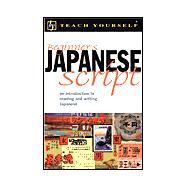
| Introduction | p. vii |
| p. 1 | |
| Introduction | p. 2 |
| Work it out! | p. 3 |
| Linking kanji to pictures 1 | p. 4 |
| Days of the week | p. 5 |
| Reading practice | p. 6 |
| Writing practice 1 | p. 8 |
| Conclusion | p. 11 |
| p. 12 | |
| Introduction | p. 13 |
| Work it out! | p. 13 |
| Linking kanji to pictures 2 | p. 14 |
| Kanji build up | p. 15 |
| Working out the meaning | p. 17 |
| Review | p. 17 |
| Reading practice | p. 18 |
| Kanji readings | p. 20 |
| Writing practice 2 | p. 24 |
| Conclusion | p. 27 |
| Test | p. 28 |
| p. 29 | |
| Introduction | p. 30 |
| Numbers 1-10 | p. 30 |
| Numbers 11-99 | p. 32 |
| Five new kanji | p. 34 |
| More about dates | p. 36 |
| The Japanese calendar | p. 36 |
| Reading practice | p. 38 |
| Kanji readings | p. 39 |
| Writing practice 3 | p. 40 |
| Conclusion | p. 42 |
| p. 43 | |
| Introduction | p. 44 |
| Finding clues | p. 44 |
| More kanji components | p. 46 |
| Reading practice | p. 49 |
| More kanji compounds | p. 51 |
| Kanji readings | p. 52 |
| Writing practice 4 | p. 54 |
| Conclusion | p. 57 |
| Test | p. 58 |
| p. 59 | |
| Introduction | p. 60 |
| Work it out! | p. 60 |
| How to read hiragana | p. 60 |
| The hiragana chart | p. 61 |
| Contracted sounds | p. 67 |
| Hiragana that change their sound | p. 68 |
| The small [characters not reproducible] (tsu) | p. 69 |
| Reading practice | p. 70 |
| Hiragana and kanji | p. 71 |
| Conclusion | p. 72 |
| p. 73 | |
| Introduction | p. 74 |
| Work it out! | p. 74 |
| Decoding kanji | p. 76 |
| Abstract kanji | p. 78 |
| Complex kanji | p. 78 |
| Kanji compounds | p. 80 |
| Kanji compounds 2 | p. 81 |
| Kanji readings | p. 82 |
| Writing practice 5 | p. 83 |
| Conclusion | p. 85 |
| Test | p. 85 |
| p. 87 | |
| Introduction | p. 88 |
| Types of kanji | p. 88 |
| Kanji components | p. 89 |
| More about radicals and components | p. 90 |
| Locating the radical | p. 93 |
| Kanji readings | p. 94 |
| Using kanji dictionaries | p. 96 |
| Writing practice 6 | p. 98 |
| Conclusion | p. 102 |
| p. 103 | |
| About this unit | p. 104 |
| Introduction | p. 104 |
| Work it out! | p. 105 |
| Kanji for places | p. 105 |
| More about places | p. 108 |
| More place names | p. 108 |
| Kanji signs | p. 111 |
| More signs | p. 114 |
| A map of Japan | p. 115 |
| Warning signs | p. 117 |
| Pairs of signs | p. 118 |
| Miscellaneous signs | p. 118 |
| Conclusion | p. 121 |
| p. 125 | |
| Introduction | p. 126 |
| Work it out! | p. 126 |
| How to read katakana | p. 127 |
| The katakana chart | p. 128 |
| Pronunciation of r and l | p. 130 |
| Katakana that change their sound | p. 131 |
| Contracted sounds | p. 135 |
| The small (tsu) | p. 136 |
| Extra katakana sounds | p. 136 |
| Contracted words | p. 139 |
| Reading practice | p. 140 |
| Writing practice 7 | p. 147 |
| Conclusion | p. 148 |
| p. 149 | |
| Introduction | p. 150 |
| Grammar functions | p. 150 |
| Writing letters | p. 169 |
| Conclusion | p. 175 |
| Key to the activities | p. 176 |
| Japanese-English | p. 187 |
| English-Japanese | p. 197 |
| Taking it further | p. 202 |
| Table of Contents provided by Ingram. All Rights Reserved. |
The New copy of this book will include any supplemental materials advertised. Please check the title of the book to determine if it should include any access cards, study guides, lab manuals, CDs, etc.
The Used, Rental and eBook copies of this book are not guaranteed to include any supplemental materials. Typically, only the book itself is included. This is true even if the title states it includes any access cards, study guides, lab manuals, CDs, etc.